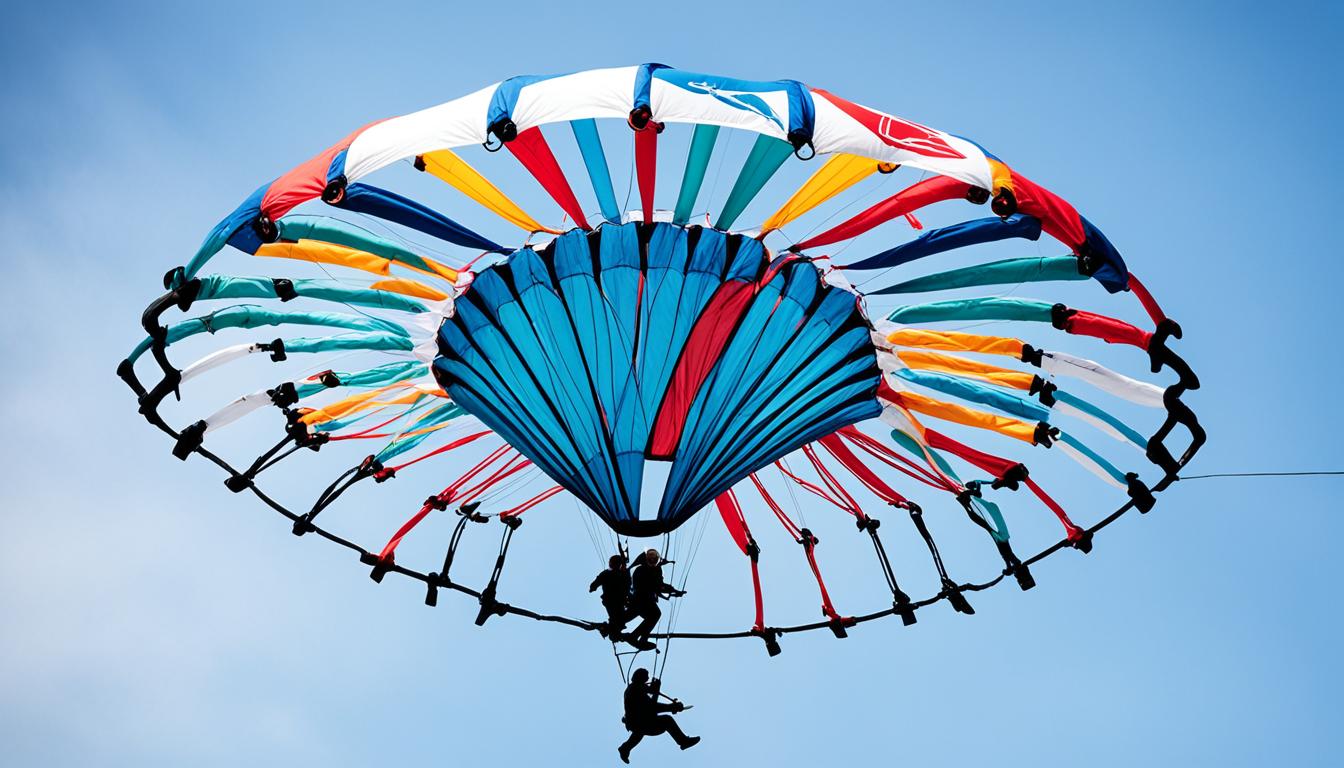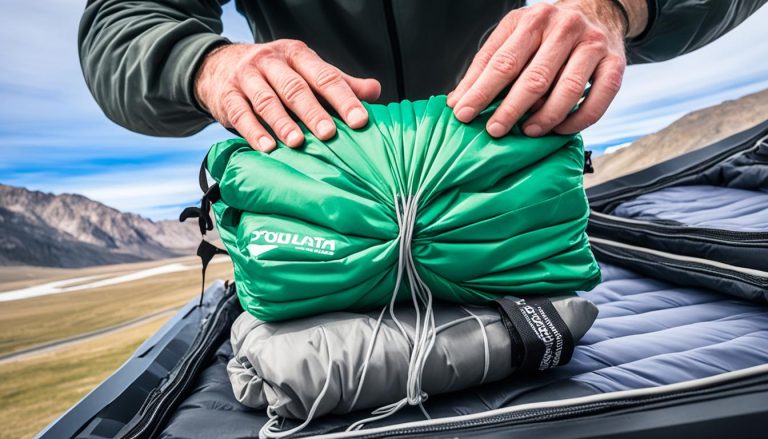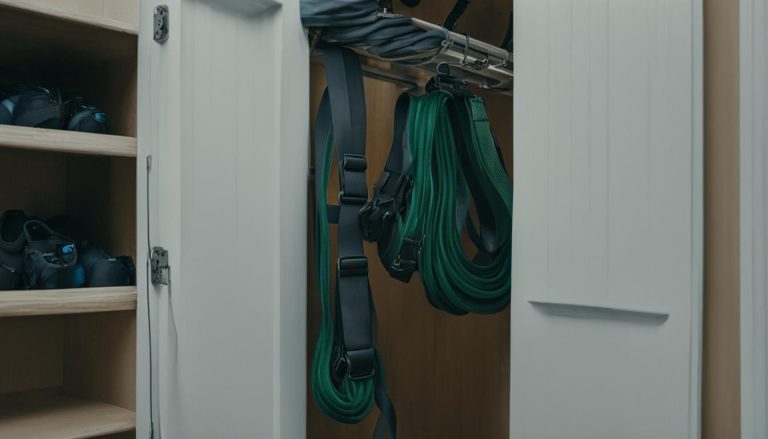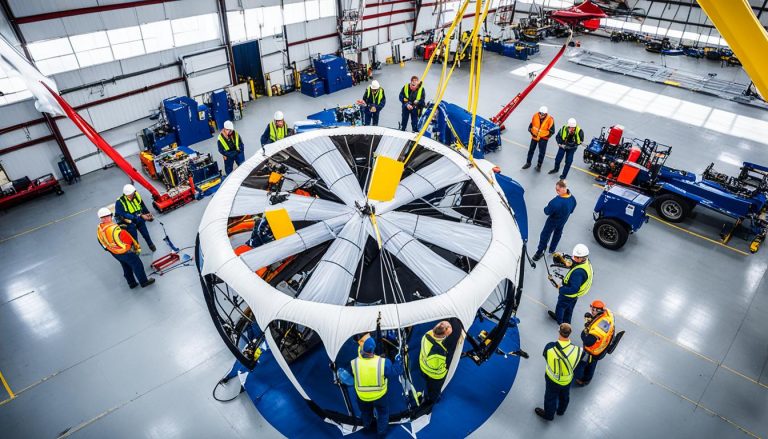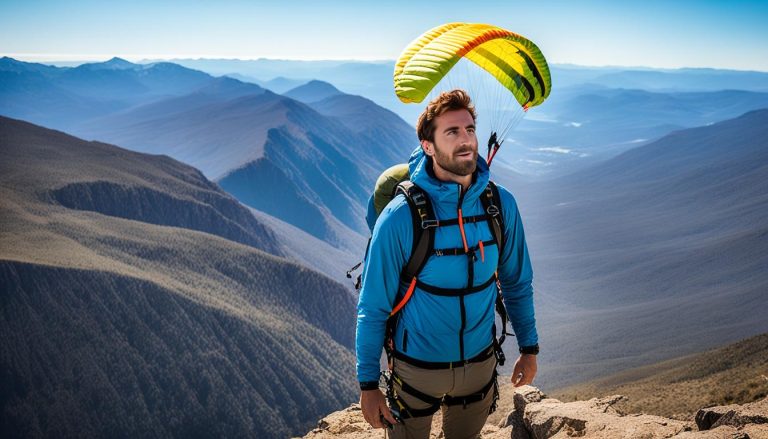The Anatomy of a Parachute: Understanding Its Components
A parachute is comprised of various components that work together to ensure its function, safety, and operation. Understanding the structure of a parachute and its individual components is essential for anyone involved in skydiving or needing to describe specific parts for maintenance or discussions.
Each component of a parachute plays a crucial role in the overall functioning of the parachute and contributes to the parachutist’s safety and control during a jump. From the main parachute or canopy to the reserve parachutes, harness, container, and various other essential components, every element has a specific function and is designed to enhance safety and operational efficiency.
By gaining a comprehensive understanding of these parachute components, individuals can enhance their knowledge of parachute structure, ensuring a safe and controlled jump experience. Whether you are a skydiver seeking to deepen your understanding or someone involved in parachute maintenance, this article will provide valuable insights into the anatomy of a parachute and its vital components.
The Main Parachute/Canopy
The main parachute or canopy is the central element of the parachute system. It is typically made of strong nylon material and is responsible for slowing down the speed of the fall by exerting air resistance. The design and fabrication of the parachute canopy are crucial to ensure its functionality and safety.
The size of the main parachute can vary depending on factors like the type of jump and the jumper’s weight. Parachute designers carefully consider these factors to determine the appropriate dimensions for a specific jump scenario. The fabrication process involves stitching together panels of nylon fabric to form the canopy, ensuring its durability and strength.
Parachute deployment is a critical aspect of the jump. The main parachute is deployed through the activation of the hackie, ripcord, or pilot chute. These devices are strategically located at waist height for quick and easy access by the jumper. When deployed, the main parachute rapidly inflates as air fills the canopy, providing the necessary resistance to slow down the descent.
Functionally, the main parachute plays a vital role in the safe landing of the jumper. By harnessing air resistance, it decelerates the fall and allows for a controlled descent. The canopy provides both horizontal and vertical lift, enabling the parachutist to steer and navigate the descent path.
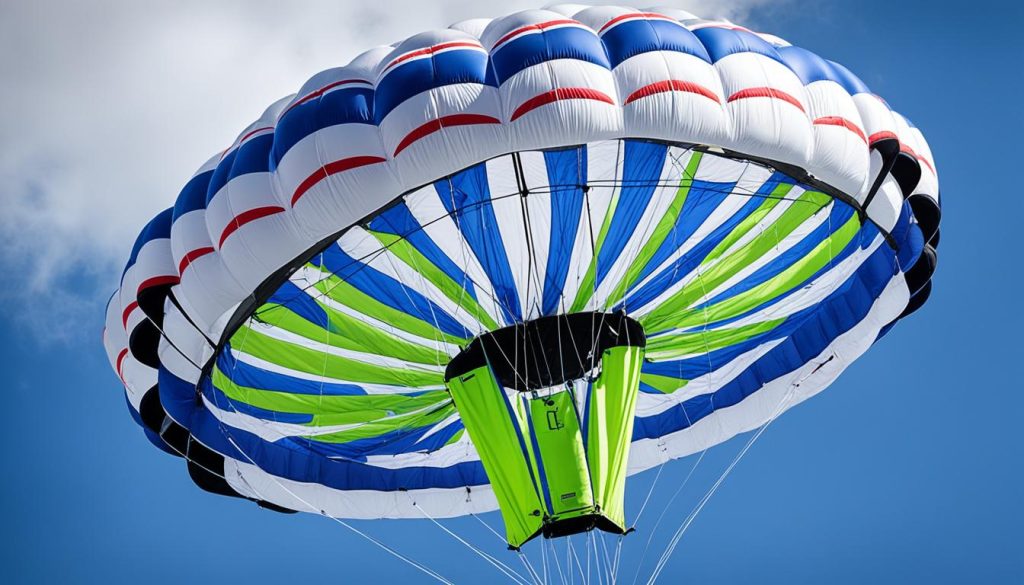
Parachute Deployment
The correct deployment of the main parachute is crucial for a successful jump. It is essential to ensure that the parachute is properly packed and the deployment mechanism is in good working condition.
During the deployment process, the jumper’s actions determine how the parachute unfolds and inflates. A well-executed deployment leads to a fully inflated and functional canopy.
In the event of an emergency or malfunction, understanding the function and design of the main parachute can help the jumper make informed decisions and take appropriate actions.
The Function of the Main Parachute/Canopy
The main parachute’s primary function is to slow down the descent speed, allowing for a safe landing. By creating air resistance, the canopy reduces the rate of fall, ensuring a controlled descent. The carefully engineered design and construction of the canopy enable it to handle large amounts of air pressure and provide stability during the jump.
The main parachute’s function goes beyond just slowing down the fall. It also allows the parachutist to steer, change direction, and navigate the descent path. By manipulating the steering toggles attached to the canopy, the jumper can control the amount of lift and drag, thus altering the descent trajectory.
The main parachute plays a critical role in ensuring a successful and safe skydiving experience. Proper understanding of its design, fabrication, deployment, and function is essential for every jumper.
Other Essential Components
In addition to the main parachute, a parachute system consists of several other essential components that contribute to parachute safety and operation. These components work in tandem to ensure a successful jump and a safe descent.
One important component is the slider, which is a small rectangular piece made of nylon. The slider plays a vital role in the parachute’s deployment process, as it helps control the rate and manner in which the canopy opens. By gradually reducing the air resistance during deployment, the slider ensures a smooth and controlled opening of the parachute canopy, minimizing the risk of an abrupt and potentially dangerous deployment.
Stabilizers are another crucial component of a parachute system. These are designed to stabilize the parachute during flight, maintaining its direction and minimizing any unwanted oscillations or swing movements. Stabilizers enhance the jumpers’ control, stability, and overall safety throughout the descent.
The harness is a vital component that ensures the jumper’s safety and comfort during the jump. It is typically made of sturdy webbing and is responsible for distributing the jumper’s body weight evenly. This even distribution of weight helps prevent strains or discomfort during the descent and assists with symmetrical openings of the parachute canopy.
The container serves as a backpack for storing the parachute equipment. It houses essential elements such as the bag, parachutes, pilot chute, and lines. The container provides protection and convenient storage for these components and helps maintain their integrity during the jump.
In case of a rare occurrence where the main parachute fails to open properly, reserve parachutes are included as a backup system. Reserve parachutes have their own handle for activation. They are designed to deploy and provide a safe descent in case of an emergency, ensuring the jumper’s safety in critical situations.
“These additional components are essential for parachute safety and the smooth operation of the system, providing enhanced control, stability, and backup options to ensure a safe and enjoyable skydiving experience.” – Skydiving expert
Summary of Other Essential Components
| Component | Description |
|---|---|
| Slider | A small rectangular piece made of nylon that controls the rate of canopy deployment |
| Stabilizers | Components that stabilize the parachute during flight and minimize unwanted movements |
| Harness | Webbing that distributes the jumper’s body weight evenly and provides comfort |
| Container | A backpack-like structure that stores the parachute equipment |
| Reserve Parachutes | Backup parachutes that deploy in case the main parachute fails |
By understanding and appreciating the significance of these other essential components, skydivers can ensure optimum parachute safety and operation. The combination of these components, alongside the main parachute, forms a comprehensive system that provides control, stability, and emergency options for a successful and secure skydiving experience.
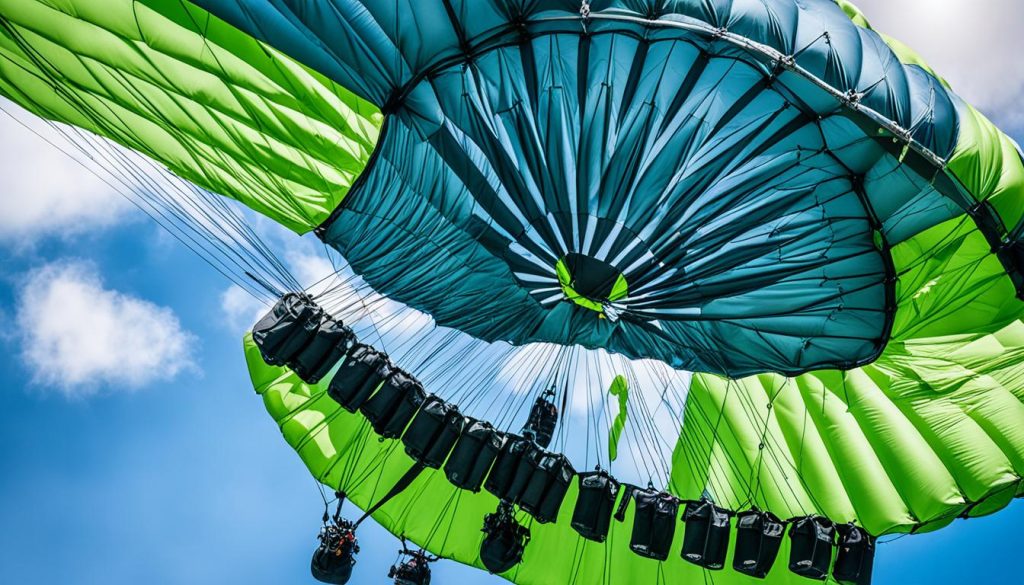
Additional Components and Equipment
Other components and equipment that are part of the parachute system contribute to overall parachute safety and operation. These include the Reserve Static Line (RSL), toggles, altimeter, three ring system, and a hook knife.
The Reserve Static Line (RSL) plays a critical role in parachute safety. It connects the risers of the main canopy to activate the reserve parachute automatically if needed. This additional safety measure ensures that in the unlikely event of a malfunction or failure of the main parachute, the reserve parachute will be deployed.
The toggles are essential for the parachutist to maintain control during descent. They allow the jumper to steer the parachute, controlling the direction and angle of descent once the canopy is open. By manipulating the toggles, the parachutist can navigate landing zones and adjust the parachute’s flight path.
The altimeter is a barometric device that provides accurate information about the jumper’s altitude relative to the ground. It helps the parachutist determine the appropriate time to deploy the parachute. With precise altitude readings at various stages of the jump, the parachutist can activate the canopy at the ideal moment, ensuring a safe and controlled descent.
The three ring system is a mechanism designed to minimize the force required to disconnect the main canopy if necessary. It consists of a set of interlocking metal rings that connect the main canopy to the rest of the equipment. The three-ring system allows for easy and quick release of the main canopy, enhancing the jumper’s safety in emergency situations.
A hook knife is included as part of the parachute system for potentially life-saving reasons. In rare circumstances where a jumper is tangled in lines or harness material, the hook knife can be used to cut through these entanglements, enabling a safe and controlled landing. It is a crucial tool that allows parachutists to free themselves from potentially hazardous situations.
These additional components and equipment contribute to a comprehensive and robust parachute system, ensuring the safety and operation of every jump. The Reserve Static Line, toggles, altimeter, three ring system, and hook knife all play a vital role in mitigating risks and providing peace of mind to skydivers.
Table: Components and Equipment in a Parachute System
| Component/Equipment | Function |
|---|---|
| Reserve Static Line (RSL) | Connects risers to activate reserve parachute in case of main canopy malfunction |
| Toggles | Allows parachutist to control direction and angle of descent |
| Altimeter | Provides altitude information for precise parachute deployment |
| Three Ring System | Minimizes force required to disconnect main canopy |
| Hook Knife | Allows for cutting lines or harness material in emergency situations |
Conclusion
Understanding the anatomy of a parachute and its components is crucial for individuals involved in skydiving or those needing to describe specific parts for maintenance or discussions. Each component of the parachute system serves a specific function and contributes to the overall safety and operation. By familiarizing themselves with these components and their roles, skydivers can enhance their understanding of parachute functionality and ensure a safe and controlled jump experience.
From the main parachute or canopy, slider, and stabilizers to the reserve parachutes, harness, and container, each component plays a vital role in successfully slowing down the fall and maintaining stability during the descent. The reserve static line (RSL), toggles, altimeter, three ring system, and hook knife provide additional safety measures and control for the parachutist.
Parachute safety is paramount, and understanding how each component operates and interacts is crucial for a successful jump. By comprehending the functions and interdependencies of the various components, skydivers can confidently navigate the skies, knowing they have the knowledge and equipment necessary to ensure a safe landing. Proper training, ongoing maintenance, and adherence to safety protocols are equally important to maintain the optimal operation of the parachute system.
So whether you are an experienced skydiver or a novice venturing into the world of parachuting, recognizing the importance of parachute safety and operation is fundamental to a successful and thrilling skydiving experience.

